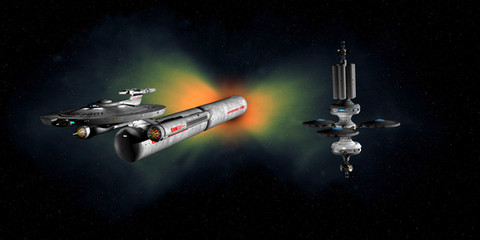HOME | DD
 NewDivide1701 — Perspective
NewDivide1701 — Perspective

#2001 #alien #aliens #antimatter #arthurcclarke #exploration #mars #sciencefiction #scifi #solarsystem #space #stanleykubrick #starsystem #warp #warpdrive
Published: 2020-12-30 15:30:44 +0000 UTC; Views: 7553; Favourites: 69; Downloads: 19
Redirect to original
Description
I have the dimensions of this ship on a previous post, but decided to show how big it is when compared to the USS Enterprise.
And when someone said for me to use the MAV from, "The Martian (2015)," instead of the lander I had used and after I commented we are better off with Thunderbird 2 from, "Thunderbirds 2086 (1982)," I decided to look up the lander from The Martian to get a little thing like the dimensions on the ship, and I found this MAV - Mars Ascent Vehicle - on Facebook by Starship Dynamics:
www.facebook.com/starship.dyna…
And estimating 2m for the astronaut and spacesuit, with a little redesigning, the cylindrical modules near the fuel tanks can each store 1 MAV with heat shields, totaling 4 MAVs, along with the space probes. The MAVs would be for landing on planets with survivable atmospheres -- as in not the hellish atmosphere of Venus, but Earth or Mars style atmosphere -- while others would use landing probes and rovers. So no need for ships that are designed for launching probes, satellites or telescopes and other ships that uses landers, but a combination of lander and probe launcher which to me would make the greatest amount of sense.
The thing is the MAV on that Facebook site is designed to use liquid oxygen and liquid methane. It can be generated on Mars by using what is known as the Sabatier reaction where CO2 and H2 and 400°C which produces CH4 and H2O. And the O2 comes from H2O generated by the reaction, and reuse the H2. Plus they use a nuclear power source due to a little thing called thermodynamics.
en.wikipedia.org/wiki/Sabatier…
But on planets where atmospheric composition is unknown at the time, then the MAV variants are actually nuclear powered VASIMR engines and using -- say liquid nitrogen to fuel the ship and keep the engine cool. Or something that's more susceptible to the microwaves that are used in the engine. And to maintain the Bob Lazar factor, those MAVs are powered by element 115.
The reason why they just don't use these ships to land on planets or moons with no atmosphere like the moon or Mercury, then you wasted a perfectly good reentry shield. And it would make sense as to why the ship has 4 VASIMR engines to balance out the reduced and unbalanced mass of dropping off probes and landing craft.
It just has no phasers or photon torpedoes, and the only shield is a magnetic shield to protect the ship from radiation bursts. So it won't be fighting Klingons any time soon.
Besides, where as the Enterprise has subspace radio, this ship only has focused, tight beam radio transmitter dishes that is most likely 7.145 GHz frequency -- 0.04195836m or 4.195836cm wavelength -- since that's the frequency the, "Hello From Earth," sent to Gliese 581 back in 2008. This is because it's believed any transmission is best sent between 1 GHz and 10 GHz as what SETI scans for.
And explains why we haven't heard from anyone since TV frequencies in Canada and the US are between 54 and 216 MHz, and UHF are between 400 MHz and 700 MHz. Well below the 1 GHz -- 1000 MHz -- that SETI listens to. That and after 100 light years, FORGET IT according to this site:
www.sciencealert.com/humanity-…
Back to the radio, it has 2 transmitters in case one burns out. And the whole ship needs to aim towards Earth to save on mass and reducing the complexity of the ship to reduce the chances of a breakdown since this ship doesn't have Tron style molecular 3D laser printers like what we saw on the Short Treks episode, "The Trouble With Edward." And therefore they have to hope there are no major problems since the earliest Earth will receive an S.O.S is over 4 years. But then again like on, "Aliens (1986)," when they start to worry with the ship being over due of returning home. And that could be several months at least, possibly a year -- as opposed to 17 days.
Related content
Comments: 4

👍: 0 ⏩: 0

👍: 0 ⏩: 0

👍: 3 ⏩: 0



























